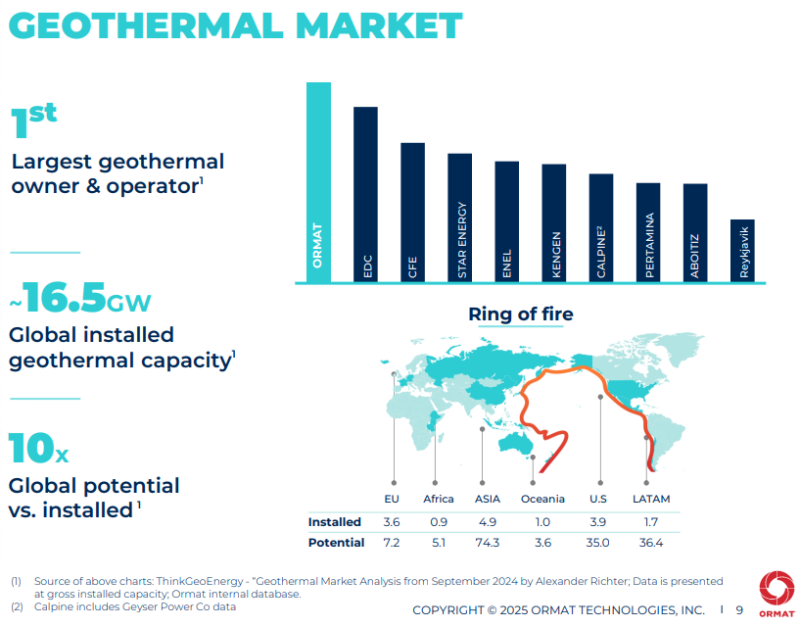The US Department of the Interior announced on 30 May the launch of emergency permitting procedures designed to accelerate the review and approval of geothermal energy projects deemed critical to national security and energy dominance.
The move follows the national energy emergency declared by President Donald J. Trump on 20 January 2025. These new measures streamline environmental reviews to help fast-track renewable energy development while upholding environmental protections.
“Geothermal energy is a reliable energy source that can power critical infrastructure for national security and help advance energy independence,” said Interior Secretary Doug Burgum. “By cutting red tape and advancing President Trump’s American Energy Dominance agenda, we’re fast-tracking reliable energy projects while strengthening national security and supporting American workers.”
First Projects To Benefit: Ormat's Nevada Developments
Three geothermal projects led by Ormat Technologies Inc. will be the first to move through the expedited process.
- Diamond Flat Geothermal Project (near Fallon): Ormat will drill test wells and assess the commercial viability of the geothermal reservoir on federally leased land.
- McGinness Hills Geothermal Optimization (Lander County): The project will expand three existing power plants by adding new wells, advanced heat exchangers, cooling fans, and a 15-MW solar PV field—potentially increasing output beyond the current 193-MW capacity.
- Pinto Geothermal Project (near Denio): Exploration and test drilling on public lands to evaluate geothermal energy potential.
BLM To Complete Reviews in 14 Days
Under the new process, the US Bureau of Land Management (BLM) will complete environmental assessments in just 14 days—a sharp drop from the typical year or more. Full environmental impact statements, which usually take up to 2 years, will now be finalized in just 28 days.
The expedited permitting reviews apply to a broad range of traditional energy developments, including oil and natural gas, natural gas liquids, refined petroleum products, uranium, coal, biofuels, geothermal energy, kinetic hydropower, and critical minerals.
Ormat’s Journey

- Ormat was established in 1965 by Lucien Y. Bronicki and his wife, Dita, according to the company’s website. Building upon Bronicki’s patents and research performed at the National Laboratory, the aim was to continue the development, manufacturing, and commercialization of a small solar turbine following the discontinuation of the project in the laboratory due to budget constraints. In 1966, Ormat’s first 600-W solar-powered Organic Rankine Cycle (ORC) unit, which drove an electric water pump, was installed in Mali.
- Fast forward to the 1980s when Ormat transitioned from a supplier of power equipment to a power plant turnkey provider, which expanded to owner and operator of geothermal plants, including exploration, development, and operation of geothermal fields. In 1984, the Wubaska (Nevada) 700-KW ORC geothermal power plant was the first commercial ORC in operation in the US. In 1986, the 30-MW Ormesa 1 (geothermal power plant in Holtville, California) was put in operation, according to Ormat.
- In 2011, the US Department of Energy issued a $350 million partial loan guarantee under the Financial Institution Partnership Program to finance Ormat's three geothermal power plants across northern Nevada.
- Last year, Ormat and SLB agreed to a strategic collaboration to develop and deliver integrated geothermal projects. SLB said in a press release that it has been involved in 80% of the world’s geothermal power projects. Combined with Ormat being the largest manufacturer of geothermal binary equipment and the largest owner and operator of geothermal fields and power plants under management, the companies see benefits to be gained by their complementary strengths.
- Earlier this month, a subsidiary of Ormat Technologies signed an agreement to acquire the 20-MW Blue Mountain Geothermal Project in Nevada from Cyrq Energy LLC for $88 million. Closing is expected at the end of June, Ormat said in its Q1 2025 presentation. The plant was originally built by Ormat in 2009. Planned upgrades include 3.5 MW additional capacity by 2027 and 13 MW of solar PV for the geothermal auxiliary.


